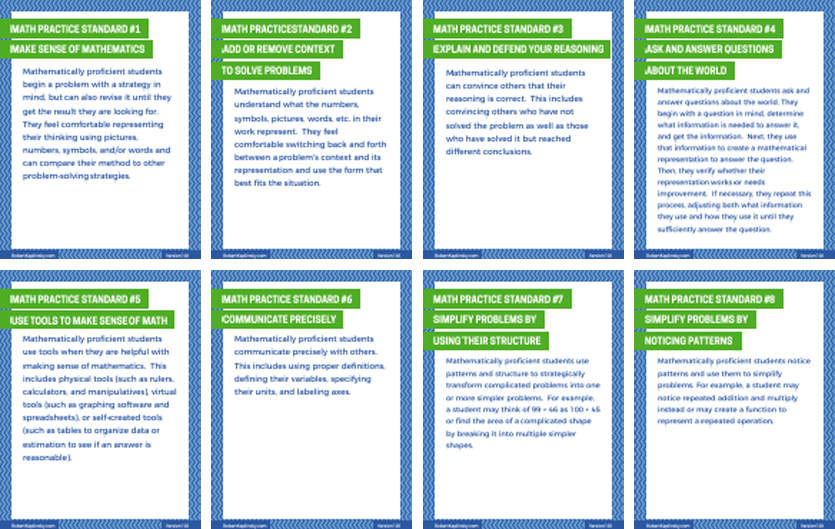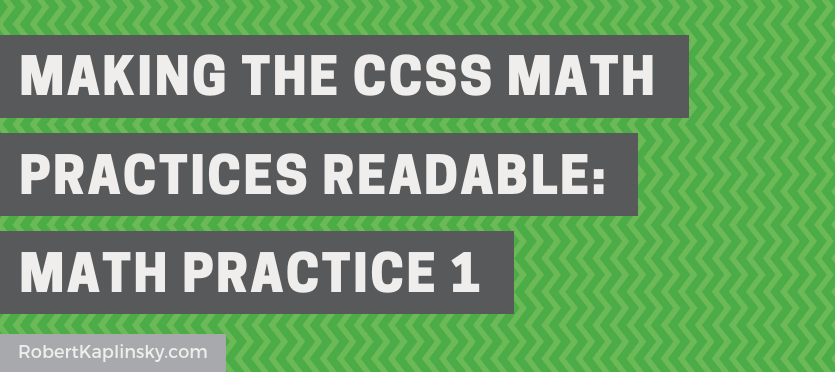This is the first of an eight blog post series where I’ll attempt to make a version of each of the Common Core State Standards’ Math Practices that educators, parents, and students can all understand. Simply put, the Math Practices are really tough to make sense of, which means that few educators have read them in full paragraph form and even fewer confidently understand them.
- My guiding principle comes from Antoine de Saint Exupéry who said “perfection is attained not when there is nothing more to add, but when there is nothing more to remove.” Certainly I could always add more details, but my goal is to make each standard as succinct as realistically possible and stop.
- I will make significant changes while still preserving what I believe to be each standard’s essence.
- I’ll also copy and paste the official math practice for comparison.
- I’ll add notes to explain my reasoning.
I realize that inevitably my version will also be flawed. Mainly I’m just curious to see if I can do any better. Thanks in advance for leaving me constructive criticism in the comments below so I can improve them.

Math Practice 1: Make sense of mathematics.
Mathematically proficient students begin a problem with a strategy in mind, but can also revise it until they get the result they are looking for. They feel comfortable representing their thinking using pictures, numbers, symbols, and/or words and can compare their method to other problem solving strategies.
Math Practice 1: Make sense of problems and persevere in solving them.
Mathematically proficient students start by explaining to themselves the meaning of a problem and looking for entry points to its solution. They analyze givens, constraints, relationships, and goals. They make conjectures about the form and meaning of the solution and plan a solution pathway rather than simply jumping into a solution attempt. They consider analogous problems, and try special cases and simpler forms of the original problem in order to gain insight into its solution. They monitor and evaluate their progress and change course if necessary. Older students might, depending on the context of the problem, transform algebraic expressions or change the viewing window on their graphing calculator to get the information they need. Mathematically proficient students can explain correspondences between equations, verbal descriptions, tables, and graphs or draw diagrams of important features and relationships, graph data, and search for regularity or trends. Younger students might rely on using concrete objects or pictures to help conceptualize and solve a problem. Mathematically proficient students check their answers to problems using a different method, and they continually ask themselves, “Does this make sense?” They can understand the approaches of others to solving complex problems and identify correspondences between different approaches.
- You might wonder why I removed the portion of the title that says “and persevere in solving them”. When you read through each of the sentences in the official version of the standard, you will see zero references to perseverance. While it might be an implied part of problem solving, the standard is completely about sense making, not perseverance. I have seen this become problematic when educators see students who are not making sense but are also not giving up. They believe this demonstrates MP 1. It’s great when students don’t give up, but if the students are not making sense of mathematics, then the students are not demonstrating Math Practice 1.
- I ultimately decided to delete a large portion of the standard because while it lists several examples of what sense making might look like, I feel it just makes it more confusing.


I would love this resource, but I can’t get the form to submit.
Hi Kelly. Sorry about that. Maybe try on a computer?
Hi Robert,
I came into contact with your work thanks to Alice Keeler (with whom I became familiar in buying her book on using Google in the classroom). I am a middle-aged career-switcher, currently working on my ELED MAT. I’m a huge “fan” of your work because it distills the essence of mathematics for those who attend to simplification in order to achieve understanding.
Anyway, I find your treatment of MP 1 to be flawless. It very much aligns with the way I try to distill overarching concepts and ideas in all of my reading, and then try to explicate it in oral or written form, which is, after all, teaching! Eliminating the examples does much to eliminate needless density, for sure. I’ll work through each of the remaining 8 and let you know if I can think of any useful feedback. This past week, as luck would have it, I started my methods of teaching math course. MPs are obviously at the center of the content. Thanks to Alice, and her miracle Google sheet of digital resources, I found reference to this post and came a looking for you, again!
Best,
Scott
Hi Scott. Welcome to the profession. Teaching was also my second career. Alice Keeler is great and generously shares so many ideas with others. Good luck with your methods course!
Hello, I love this resource, and I think it’s very important to make the math practices more accessible while not changing their intent!
With this first one, I’m wondering about the phrase “begin a problem with a strategy in mind.” I think part of making sense of difficult problems is digging in and start work on a problem without a strategy in mind. It’s about a willingness to play around and see what’s happening. Sometimes, once I start to make sense of the information and relationships in the problem, then a strategy can form. Math Practice #1, to me, referred to that whole process of sorting through the information given in order to then choose a strategy or solution path, and then being metacognitive throughout the process of solving.
Thanks for this pushback. So I definitely do some guess and check myself so I feel ya. But in terms of the scope of this project, I’ve defined it as against the rules for me to add my own beliefs into the standards. I’m just trying to make what is already in the standards more understandable.
I look forward to reading each of these. I work diligently in providing math instruction to my students, who are in my math intervention class, to promote math learning. I really believe that as an educator, if I understand each MP, and plan my lessons around them, I will ensure the best math instruction to math learners.
Once I have read through each of these, I will provide you with thoughtful feedback.
Thanks Michelle.
What a great idea to make the practices more user friendly for both teachers and parents! I have taught 6th grade math for many years and am now a math coach for grades K-6 and an AIS provider. I have read through your revision for the first practice on this page and really like the way you have reworded it. One thing that I wouldn’t remove would be the line toward the end that speaks to students asking themselves if it makes sense. Later, we refer to this as “Reasonableness.” So many times students find an answer but never check to see if it makes sense in the context of the question. I believe that the beginning of that dilemma is an understanding of the problem in the beginning and then an estimate of a reasonable answer. That’s a topic for another discussion! 🙂
Very valid pushback. It was a super subjective process, and I can certainly see the value of adding that part back in.
Hi Robert,
I love this effort. I have used your more readable practice standards with teachers for past 2-3 years. The math practice standards are often ignored because of how they are presented in the standards documents and the fact that they are written in very dense language. Your effort unpack them and makes them far more accessible and meaningful for teachers. Thank you!
Today I re-read this one (MP1) with new eyes and I feel there is something missing. This line from the original: “They consider analogous problems, and try special cases and simpler forms of the original problem in order to gain insight into its solution.” says to me “They use math they know to make sense of math they don’t know.” When teaching through problem solving, students will use strategies or models that have worked for them in the past (i.e. analogous problems/simpler forms).
What are your thoughts?
That absolutely works, Glen. I totally see where you’re coming from. I guess it comes down to my guiding principle from Antoine de Saint Exupéry who said “perfection is attained not when there is nothing more to add, but when there is nothing more to remove.” Certainly I could always add more details, but my goal is to make each standard as succinct as realistically possible and stop.
Where to draw that line is super subjective. I could have included your statement for sure.
‘Mathematically proficient students begin a problem with a strategy in mind,…’
Since students first have to identify what of the given information is relevant (what they know about a problem), are you implying that proficiency comes when students have a strategy in place?
What I mean is more that rather than banging numbers together (like this: https://robertkaplinsky.com/how-old-is-the-shepherd/), kids begin tackling the problem with a strategy. To some degree, what information is relevant will depend on what your strategy is.
For example, with this drug money problem (https://robertkaplinsky.com/work/drug-money/) some students will think that they could count all the bills and will want the dimensions of the pile as relevant info. Some kids will want to weigh all the money and will want to know about how much a bill weighs and how much all the money weighs as relevant info.
So, ideally they have some idea or strategy in mind for how they plan to tackle the problem.
Robert, are you ok with us adding your work into a document my school uses regarding math for teachers. The work would be cited with your name. Thank you for your consideration.
Sorry for the late reply. Yes, absolutely. Thanks for asking.